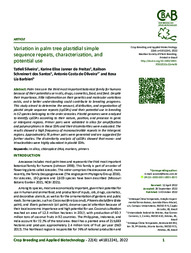Variation in palm tree plastidial simple sequence repeats, characterization, and potential use.
Variation in palm tree plastidial simple sequence repeats, characterization, and potential use.
Author(s): SILVEIRA, T.; FREITAS, K. E. J. de; SANTOS, R. S. dos; OLIVEIRA, A. C. de; BARBIERI, R. L.
Summary: Palm trees are the third most important botanical family for humans because of their potential use in oils, drugs, cosmetics, food, and feed. Despite their importance, little information on their genetics and molecular variations exists, and a better understanding could contribute to breeding programs. This study aimed to determine the amount, distribution, and organization of plastid simple sequence repeats (cpSSRs) and their potential use in breeding in 52 species belonging to the order Arecales. Plastid genomes were analyzed to identify cpSSRs according to their nature, position, and presence in genic or intergenic regions. Primer pairs were validated in silico for amplification and polymorphisms in these SSRs and their dissimilarities were evaluated. The results showed a high frequency of mononucleotide repeats in the intergenic regions. Approximately 76 primer pairs were generated and are suggested for further studies. The dissimilarity analysis of cpSSRs showed that mono- and trinucleotides were highly abundant in plastid SSRs.
Publication year: 2022
Types of publication: Journal article
Observation
Some of Embrapa's publications are published as ePub files. To read them, use or download one of the following free software options to your computer or mobile device. Android: Google Play Books; IOS: iBooks; Windows and Linux: Calibre.
Access other publications
Access the Agricultural Research Database (BDPA) to consult Embrapa's full library collection and records.
Visit Embrapa Bookstore to purchase books and other publications sold by Embrapa.

